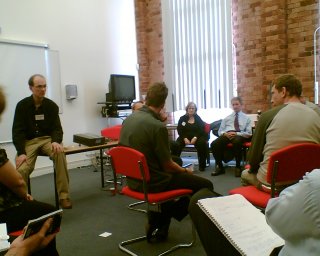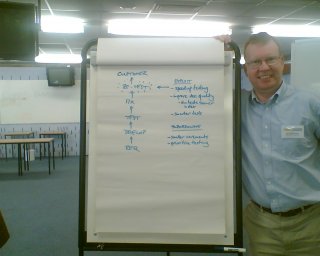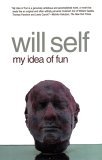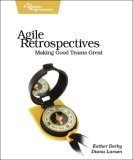 I spent a nice day at Agile North in Preston, on Sepember 20th. The Agile North group organized this one day Agile conference.
I spent a nice day at Agile North in Preston, on Sepember 20th. The Agile North group organized this one day Agile conference.
Rob Westgeest and I met at Manchester Airport with Kevin Rutherford, who drove us deftly to Preston, just before the approaching traffic jams.
The conference started with a keynote by Rachel Davies, current chair of the Agile Alliance. The talk told us how Rachel got into agile software development and her advice on moving to agile software development. Her theme was a common one among experienced agile practitioners: it’s about the values and principles. You’ll have to tailor the practices to your own situation. Start with a documented agile methodology, any methodology, the one that seems to fit your environment best. Start delivering and reflecting upon what you do. Adapt the method. And again. Use retrospectives for the reflection part (more about that later).
The first session was a goldfish bowl, organized by Charles Weir (on the left of the picture, seated on the table) about “Dealing with Customers”. Unlike most goldfish bowls I attended, this one was relaxed and featured some interesting discussion and tips on how to work effectively with customers. The audience had a nice mix of experienced people who could tell stories of success and failure, and people new to agile, looking for ways to improve their customer relationships.
The session was not about great ideas and breakthroughs. Most of it were small, simple ideas that everyone could apply, few of them specific to agile development. It does take sustained effort to create and maintain a great customer relationship. And again, the advice was to solve your worst problems (or bottlenecks) and to adapt to local circumstances.
I would have liked to attend the Rails session too, but you can’t be in two places at the same time…
 After lunch, Rob and I organized the “I’m not a bottleneck! I’m a free man!” session. In this two hour session, we first introduce the “5 focusing steps” in a simulation, where the participants are asked to implement a paper boat and hat folding company. The workers got paid in chocolates.
After lunch, Rob and I organized the “I’m not a bottleneck! I’m a free man!” session. In this two hour session, we first introduce the “5 focusing steps” in a simulation, where the participants are asked to implement a paper boat and hat folding company. The workers got paid in chocolates.
In the second hour, some people come forward with a process that they want to optimize. The other participants act as Theory of Constraints consultants, coached by Rob, Kevin and me.
In the picture, Kevin proudly displays the result of his team: at least one way each to “exploit”, “subordinate to” and “elevate” the bottleneck of the customer. This particular system has a loop in it: software is tested and if it is defective, it is fixed and tested again. If you’re going to map this process to find bottlenecks or make a “value stream map”, it’s easiest if all the loops are unrolled and you get a linear process. How do you unroll the loop? You could take the average situation (e.g. it takes one fix-retest cycle on average); you could take a specific examples (e.g. feature XYZ went through 3 fix-retest cycles); or you can put a fork with probabilities in the diagram (e.g. 80% of all cases do not need retesting, 15% need one fix-retest, 5% need two fix-retest cycles).
The last session of the day was about agile in large organisations. I was quite interested, as I currently work for a largish organisation myself. The presenter didn’t get to finish his story, because there was a rather large amount of push-back and questioning from the audience. I didn’t get the message of the session. I’m still interested in the subject, so I’d like to see the rest of the slides.
Finally, we had a panel, where the audience could ask the “experts” questions. Rob and I had to decide which one of us would be on the panel. Rob lost, so he had to answer all the difficult questions 🙂
Agile North ended with a quick pint at the pub (kindly sponsored by Kevin) and an even quicker drive back to Manchester to catch our flight back to Belgium. All in all, a good conference, nice turnout, well-organized, interesting sessions and discussions with other participants. Thanks to the organizers for inviting us. I’ve enjoyed the conference, hope you have too!
 We now tell the participants to start with the customer. Our work only generates “throughput” (value to the company) when the customer pays us in some way for something of value we give them. So, start by drawing the customer.
We now tell the participants to start with the customer. Our work only generates “throughput” (value to the company) when the customer pays us in some way for something of value we give them. So, start by drawing the customer.



 After lunch, Rob and I organized the “
After lunch, Rob and I organized the “